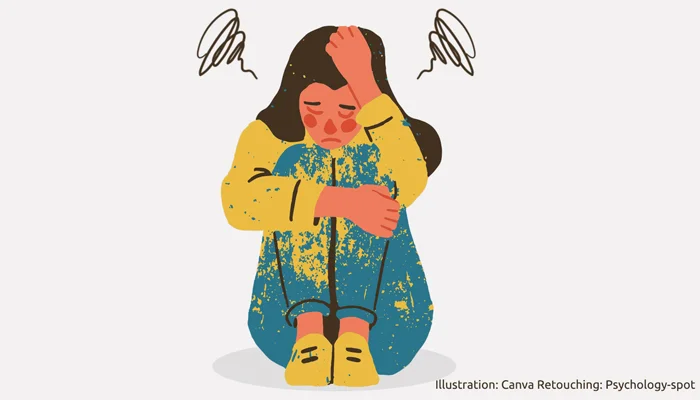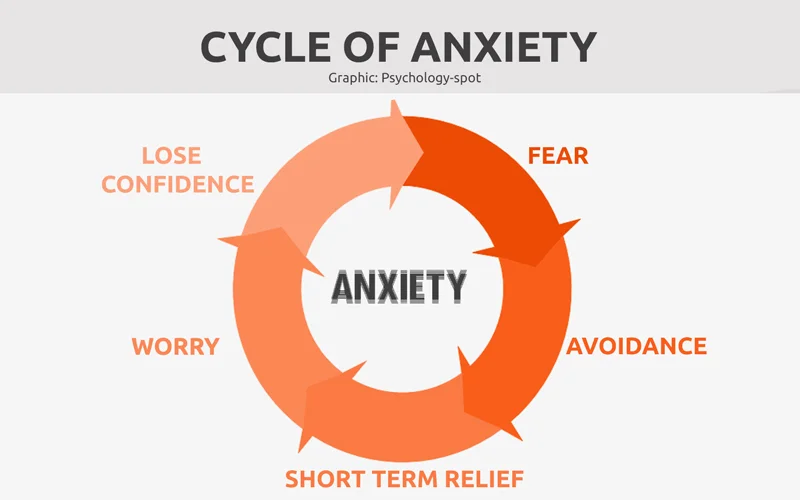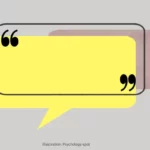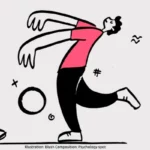
The anxiety cycle plunges us into a loop that is very difficult to get out of. And the worst of all is that it sets in relatively quickly, so that when we realize it, anxiety has already closed its loop around us, turning us into its prisoners. To paraphrase Dorothy Rowe, anxiety becomes a prison in which we are both the prisoner and the jailer. Understanding how this circle develops and knowing its different phases is essential to be able to break it or avoid falling into its downward spiral.
What are the phases of the anxiety cycle?
The vicious circle of anxiety usually begins with a specific or uncertain situation that has generated fear or apprehension and ends with the loss of confidence in our abilities, fueled largely by our worries and catastrophic thoughts.
1. Fear
At the base of anxiety there is usually a basic emotion: fear. It is not always a fear of something tangible, such as spiders, crowds, or closed spaces. Sometimes it is a diffuse fear, which we translate as a feeling of apprehension, but which deep down is nothing more than the fear that something bad may happen.
For this reason, the anxiety cycle begins with a situation (or set of situations) that generates fear and another series of uncomfortable symptoms, such as worry, anxiety, anguish, restlessness and overwhelm. When this emotional state intensifies, we can manifest physical symptoms, such as palpitations, sweating and dizziness.
2. Avoidance
Nobody likes to feel nervous and overwhelmed. It is understandable and natural. For this reason, the second phase of the anxiety cycle is avoidance. And the more intense the symptoms and discomfort we experience, the more motivated we will be to avoid them.
If we feel claustrophobia, for example, we will avoid closed spaces and if we feel anxious speaking in public, we will try to avoid these types of situations by all means. In this way we begin to structure our lives and make decisions based on the contexts that we want to avoid, with the aim of not experiencing those unpleasant symptoms again.
3. Momentary relief
Obviously, avoiding anxiety-inducing situations gives us short-term relief. Some people may begin to resort to calming rituals, such as checking to see if they’ve closed the door several times or mentally reviewing that they haven’t forgotten anything. However, in the long run these rituals can become obsessions.
At this point we usually implement what is known as safety behaviors, which are nothing more than unnecessary actions aimed at preventing, minimizing or escaping from a situation that we perceive as distressing. We can try to go unnoticed to avoid having to speak in public, drink alcohol to feel more comfortable in the social context, or even let others choose for us so as not to suffer the anxiety generated by decisions. The goal of this type of behavior is to feel safe and produce almost immediate relief from anxiety symptoms, but in the long term they are a counterproductive strategy because they end up reinforcing it.

4. Worry
Worries are the fuel that fuels anxiety. In this phase, we begin to feel stressed about being stressed. That is, we not only fear the initial phobic stimulus or the situation that triggered the symptoms, but we begin to fear the anxiety itself.
At this point we are no longer just worried about closed spaces or the prospect of having to speak in public, but we begin to question our coping strategies and capabilities. We wonder: will it be effective next time? Will I be able to control it? Will I be able to control myself? This causes us to fall into a spiral of worries and ruminative thoughts that exacerbate anxiety.
5. Loss of trust
Avoidance is the most common mechanism for coping with anxiety, but in the long run it generates more distress. If we try to escape from situations that make us feel bad, chances are that when we have to face them next time, we will have less confidence in ourselves because we have become dependent on safety behaviors. At that moment we will feel more overwhelmed, the anguish will become more uncontrollable and the cycle of anxiety around us will close.
How to break the cycle of anxiety? 3 psychological techniques
This vicious cycle plays an important role in maintaining tension, anguish and apprehension. The good news is that you can break the cycle of anxiety by creating a new, more positive cycle using the right psychological techniques.
1. Systematic desensitization
Developed by Joseph Wolpe in 1958, the systematic desensitization technique is still used due to its effectiveness, especially to treat phobias, but it can also be applied to all situations that cause anxiety.
Basically, it consists of exposing yourself to situations that stress and overwhelm you, in a controlled manner, trying to ensure that your anxiety level does not increase too much, so that you realize that they do not represent a real threat. As you approach these situations, you will gain confidence in yourself and your abilities to deal with them. This way you break the anxiety cycle right at the beginning and don’t fall into avoidance.
2. Cognitive restructuring
If worries fuel your anxiety and apprehension, you need to break the anxiety cycle precisely at that point. And to do this, there is nothing better than applying cognitive restructuring for anxiety, a technique that consists of detecting maladaptive thoughts and changing them for more realistic ideas that help you better face the challenge ahead.
Write down all the thoughts that come to your mind when you experience anxiety. Then ask yourself: Is that thought realistic? Am I basing this on facts or feelings? Is there any evidence to support that idea? You may find that it’s anxiety talking. Therefore, the next step is to look for alternative thinking. For example, if it makes you anxious the idea: “I will get so nervous that I won’t know what to say,” you can think: “I have prepared well, if I have any difficulties, I will be able to get out of it.”
3. Mindfulness
Mindfulness therapy for anxiety has proven effective in the clinical setting. The interesting thing about this approach is that it focuses on the emotional charge of thoughts, rather than their content. You don’t have to question your ideas, but just understand the emotional states they generate.
The idea is that you learn to “sit” with your emotions, even anxiety, but without trying to reject, judge or control it. It is a radical change in the way you react to anxiety that will allow you to stop seeing it as your enemy. And it is precisely at the moment when you “empty” it of the scary meaning, that you stop fearing it and you don’t need to run away from it. Then it starts to give in.
References:
Curtiss, J. E. et. Al. (2021) Cognitive-Behavioral Treatments for Anxiety and Stress-Related Disorders. Focus (Am Psychiatr Publ); 19(2): 184–189.
Rajiah, K. et. Al. (2014) The Effectiveness of Psychoeducation and Systematic Desensitization to Reduce Test Anxiety Among First-year Pharmacy Students. Am J Pharm Educ; 78(9): 163.
Hoge, E. A. et. Al. (2013) Randomized Controlled Trial of Mindfulness Meditation for Generalized Anxiety Disorder: Effects on Anxiety and Stress Reactivity. J Clin Psychiatry; 74(8): 786–792.




Leave a Reply